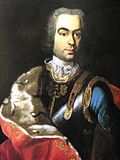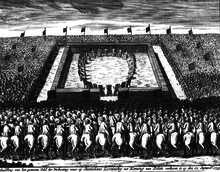Free choice (1733)
 |
||||
|
||||
|
|
||||
| Elected King of Poland and Grand Duke of Lithuania | ||||
|---|---|---|---|---|
| candidate | Stanislaus I. Leszczyński | Friedrich August II. | Infante Manuel | |
| be right | 11,697 | 906 | ||
|
|
||||
|
Elected
Stanislaus I. Leszczyński |
||||
The free election of 1733 was the tenth and penultimate election of its kind for the determination of the king and grand duke of the Royal Republic of the Polish Crown and the Grand Duchy of Lithuania by the nobility as a whole.
history
On February 1, 1733, the King of Poland and Grand Duke of Lithuania August II died in Warsaw , leaving Poland-Lithuania without a ruler. Another election as king was therefore essential. During this time, the Polish-Lithuanian nobility was decidedly against a foreign candidate, such as the Portuguese Duke Infante Manuel with the bestowed title Conde de Ourém . He was supported by the Russian Empire and the Habsburg Monarchy (see Alliance Treaty of the Three Black Eagles ). During a Sejm assembly in June 1733, the Primate of Poland, Interrex Teodor Potocki, suggested that no foreign candidacy should be considered. The application was accepted by the two most influential Polish magnate families : the Potocki family and the Czartoryski family . Furthermore, the Protestants were banned from all public offices by the Roman Catholic, conservative nobility. In the light of these events, the former King Stanislaus I. Leszczyński emerged as the most obvious candidate. Leszczyński himself was not well remembered by the Poland-Lithuania confederation. During his reign (1704–1709) he was considered a puppet of the Swedish Empire and left it after the battle of Poltava . In 1725 his daughter married Maria Leszczyńska , Louis XV. so that she became Queen of France and the Kingdom of Navarre . As a result of this marriage, Leszczyński's popularity among the Polish nobility was widespread, as his election was linked with the hope of strengthening Poland's international position. At the same time, the royal courts in Vienna, St. Petersburg and Berlin opposed Leszczyński, who had a positive attitude towards France, for fear of the French kingdom becoming stronger .
In July 1733 Leszczyński appeared in Versailles and soon afterwards France provided a navy that brought him from Brest to Gdansk . However, these preparations were a ruse by Cardinal André-Hercule de Fleury in order not to risk a conflict with the Kingdom of Great Britain . Therefore, Leszczyński disguised himself as a merchant named Ernest Bromback, who was accompanied by the French army officer Dandelot. They came to Poland by land after traveling through Germany.
On September 12, 1733, the nobility gathered in Wola near Warsaw and elected Stanislaus I. Leszczyński as the new king of Poland. In the vote, he received the approval of 13,500 voters. This news was received with joy in Paris. But shortly after the election, the new king fled to Danzig , where he awaited the French military adviser . The ruler feared a 30,000-strong Russian army that would enter the confederation in early August. The Russians organized a separate royal election on October 5th of the same year with only 1,000 voters who voted for Friedrich August II , the son of August the Strong . These events marked the beginning of a major European conflict known as the War of the Polish Succession .
A civil war had also broken out in the confederation. The Russian army then took Krakow , where August III. was crowned on January 17, 1734. Finally, the Russian and Saxon armies triumphed over the supporters of Leszczyński ( Siege of Danzig (1734) ). In 1736 the Sejm accepted August III's accession to the throne . and was thus King of Poland and Grand Duke of Lithuania.
swell
- U. Augustyniak, Historia Polski 1572–1795 , Warszawa 2008.
- M. Markiewicz, Historia Polski 1494–1795 , Kraków 2002.




